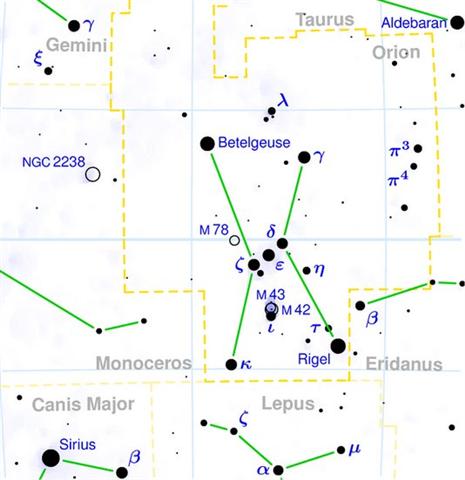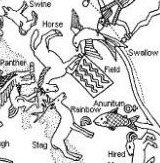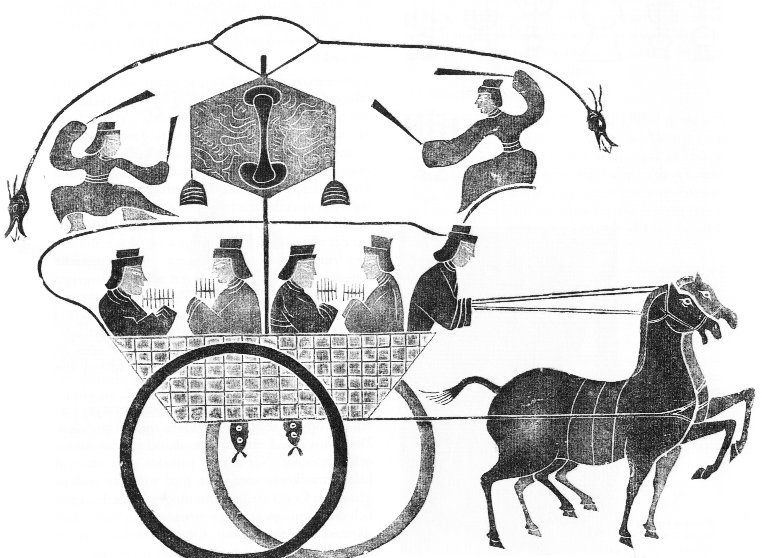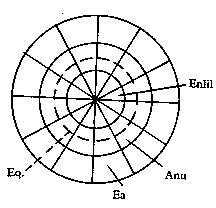431. The distance from Spica to Vega (78
days) was mirrored at the other side of the sky by the
distance from Sirrah to Rigel:


|
FEBR
5 (36) |
6
(37 = 78 - 41) |
7
(118 - 80) |
|
... the Palenque scribes repeated Creation again
and described it as 'it was made visible, the
image at Lying-down-Sky, the
First-Three-Stone-Place'. Then we learned that
five hundred and forty-two days later (1.9.2 in
the Maya system), Hun-Nal-Ye 'entered or
became the sky' (och ta chan). This
'entering' event occurred on February 5, 3112 BC
... |
 |
 |
 |
|
Ca4-1 (77) |
Ca4-2 |
Ca4-3 |
|
kua tupu te rakau |
kua tupu - te kihikihi |
te hau tea |
|
CLOSE TO THE FULL MOON: |
|
μ
Aurigae, μ Leporis (77.6) |
ĸ
Leporis (78.0),
RIGEL (Foot) = β Orionis
(78.1),
Flaming Star = IC405
(78.2),
CAPELLA = α Aurigae
(78.4), ο Columbae, τ Orionis (78.8)
*37.0 = *78.4 - *41.4
THUBAN
(α Draconis)
|
λ
Aurigae (79.0), λ Leporis (79.6), ρ Aurigae
(79.7)
ARCTURUS (α Bootis)
|
|
... In view of the almost universal prevalence
of the Pleiades year throughout the Polynesian
area it is surprising to find that in the South
Island and certain parts of the North Island of
New Zealand and in the neighboring Chatham
Islands, the year began with the new Moon after
the yearly morning rising, not of the Pleiades,
but of the star Rigel in Orion ... |
|
June
6 (157 = 314 / 2) |
7
(*78) |
8 |
|
'May
10 (*50 = *77 - * 27) |
11 |
12
(132 = 118 + 14) |
|
"April 26 (*36 = *77 - *41) |
27 |
28
(118) |
|
APRIL 3 (*13 = *77 - *64) |
4 |
5
(95 = 118 - 23) |
|
CLOSE TO THE SUN: |
|
Dec
6 (340 = 157 + 183) |
7
(*261 = *78 + *183) |
8 |
|
NODUS I = ζ Draconis
(260.0), π Herculis (260.7),
RAS
ALGETHI = α Herculis
(260.8) |
SARIN = δ Herculis
(261.0), ο Ophiuchi (261.4)
*220.0 = *261.4 - *41.4
ALRISHA (α Piscium)
|
ξ Ophiuchi (262.2), θ
Ophiuchi, ν Serpentis, ζ, ι Apodis (262.4), ι
Arae (262.8), ρ Herculis (262.9)
*221.0 = *262.4 - *41.4 |
|
Spica
(202.7 = 0.5 + 202.2) |
78.1 |
Vega
(281.8 = 78.1 + 203.7) |
|
JUNE 10 (161) |
182 |
DEC 10 (344) |
78 |
AUG 27 (240 = 281 - 41) |
182 |
FEBR 27 (464 / 8) → π |
|
Oct 9 (283) |
180 |
April 8 (464) |
77 |
Dec 27 (361 = *281) |
180 |
June 26 (177 = 361 - 184) |
|
"Aug 29 (241 = 161 + 80) |
182 |
"Febr 26 (423) |
78 |
"Oct 16 (320 = 361 - 41) |
180 |
"May 16 (136 = 448 / 8 + 80) |
|
AUG 6 (218 = 241 - 23) |
182 |
FEBR 3
(400) |
78 |
OCT 24 (297 = 361 - 64) |
180 |
APRIL 23
(177 - 64 = 113) |
|
Sirrah (0.5) |
77.6 |
Rigel
(78.1) |
|
NOV 20
(324 = 404 - 80) |
182 |
MAY 22 (142 = 183 - 41) |
77 |
FEBR 6
(37 = 78 - 41) |
182 |
AUG 8 (220 = 261 - 41) |
|
March 21 (*365) |
182 |
Sept 20 (263 = *183) |
77 |
June 7 (158 = *78) |
182 |
Dec 7 (*261 = 9 * 29) |
|
"Febr 8 (*324) |
182 |
"Aug 10 (222 = 142 + 80) |
77 |
"April 27 (117 = 158 - 41) |
182 |
"Oct 27 (300
= 341 - 41) |
|
JAN 16 (*301 = *324 - *23) |
182 |
JULY 18
(199) |
77 |
APRIL 4 (94) |
182 |
OCT 4 (277 =
300 - 23) |
This implies there ought to be 365 - 2 * 79 =
207 days for the rest of the year - or rather by
counting the year as 366 days with 1 day leaped over 3
out of every 4 years - 208 (= 2 * 104) days for the rest
of the year. However, for some reason these 208 days
were
not distributed symmetrically:
|
84 |
Sirrah |
Rigel |
124 |
Spica |
Vega |
|
0 |
78 |
203 |
281 |
|
79 |
79 |
|
366 |
384 - 20 = 364.
|
no glyph |
 |
 |
 |
 |
 |
 |
|
Ca1-1 |
Ca1-2 |
Ca1-3 |
Ca1-4 |
Ca1-5 |
Ca1-6 |
|
Sept 20 |
21 (264) |
Equinox |
23 |
24 (☼183) |
25 (*5 + *183) |
26 (☼185) |
|
"Aug 10 (222) |
11 |
12 (265 - 41) |
13 (15 * 15) |
14 |
(227 = 268 - 41) |
16 (*148) |
|
CLOSE TO THE FULL MOON: |
|
Al Fargh al Thāni-25 (Rear
Spout)
0h (365.25)
CAPH (Hand) =
β
Cassiopeiae,
SIRRAH (Navel of the Horse)
=
α
Andromedae
(0.5),
ε
Phoenicis,
γ³
Oct.
(0.8) |
Uttara Bhādrapadā-27 (2nd of
the Blessed Feet) /
Wall-14 (Porcupine)
ο Oct. (1.3),
ALGENIB PEGASI = γ Pegasi
(1.8) |
χ Pegasi (2.1), θ Andromedae
(2.7) |
σ Andromedae (3.0), ι Ceti
(3.3), ζ Tucanae (3.5), ρ
Andromedae, π Tucanae (3.7) |
no star listed (4) |
ANKAA = α Phoenicis,
κ Phoenicis (5.0)
ALPHARD (α Hydrae)
|
λ Phoenicis (6.3), β Tucanae
(6.4) |
|
CLOSE TO THE SUN: |
|
ALCHITA = α
Corvi,
MA WEI (Tail of the Horse) =
δ Centauri
(183.1),
MINKAR = ε Corvi
(183.7), ρ Centauri (183.9) |
PÁLIDA (Pale)
=
δ
Crucis
(184.6),
MEGREZ (Root of the Tail) =
δ
Ursae Majoris
(184.9) |
Hasta-13 (Hand) /
Chariot-28 (Worm)
GIENAH (Wing)
=
γ
Corvi
(185.1),
ε
Muscae (185.2),
ζ
Crucis (185.4),
ZANIAH
(Corner) =
η
Virginis
(185.9)
*144.0 = *185.4 - *41.4 |
CHANG SHA
(Long Sand-bank) =
ζ
Corvi
(186.3) |
INTROMETIDA
(Inserted) =
ε
Crucis
(187.4),
ACRUX =
α
Crucis
(187.5)
*146.0 = *187.4 - *41.4 |
γ
Com. Berenicis (188.0),
σ
Centauri (188.1),
ALGORAB =
δ
Corvi
(188.5),
GACRUX =
γ
Crucis
(188.7) |
γ
Muscae (189.0),
AVIS SATYRA
(Bird of the Satyrs) =
η
Corvi
(189.3),
ASTERION (Starry) =
β
Canum Ven.
(189.5),
KRAZ = β
Corvi,
κ Draconis (189.7) |

... Raven gazed up and down
the beach. It was pretty,
but lifeless. There was no
one about to upset, or play
tricks upon. Raven sighed.
He crossed his wings behind
him and strutted up and down
the sand, his shiny head
cocked, his sharp eyes and
ears alert for any unusual
sight or sound. The
mountains and the sea, the
sky now ablaze with the sun
by day and the moon and
stars he had placed there,
it was all pretty, but
lifeless. Finally Raven
cried out to the empty sky
with a loud exasperated cry.
And before the echoes of his
cry faded from the shore, he
heard a muffled squeak. He
looked up and down the beach
for its source and saw
nothing. He strutted back
and and forth, once, twice,
three times and still saw
nothing. Then he spied a
flash of white in the sand.
There, half buried in the
sand was a giant clamshell.
As his shadow fell upon it,
he heard another muffled
squeak. Peering down into
the opening between the
halves of the shell, he saw
it was full of tiny
creatures, cowering in fear
at his shadow ... |
I have assumed the
Easter Islanders used calendar
systems and other ideas transferred
intact from their ancient homeland (Hiva)
when naming the corresponding
features after having arrived to
their new homeland. It would be easy
to look at the face of the Full Moon
in order to deduce which stars defined the seasons of the Sun as
found out by people north of the equator.
Therefore day zero (0h) should be
directly before the beginning of the
text where
γ
Pegasi marked day 264 - i.e. the first
day after 'the Year of the Horse' (from Sirrah,
the Navel, up to and including her
tail, Ma Wei),
a season
which seems to have stretched for
184 days of warm summer grasses.
... In north Asia the common mode of
reckoning is in half-year, which are
not to be regarded as such but form
each one separately the highest unit
of time: our informants term them
'winter year' and 'summer year'.
Among the Tunguses the former
comprises 6½ months, the latter 5,
but the year is said to have 13
months; in Kamchatka each contains
six months, the winter year
beginning in November, the summer
year in May; the Gilyaks on the
other hand give five months to
summer and seven to winter. The
Yeneseisk Ostiaks reckon and name
only the seven winter months, and
not the summer months. This mode of
reckoning seems to be a peculiarity
of the far north: the Icelanders
reckoned in misseri,
half-years, not in whole years, and
the rune-staves divide the year into
a summer and a winter half,
beginning on April 14 [4-14] and
October 14 respectively. But in
Germany too, when it was desired to
denote the whole year, the combined
phrase 'winter and summer' was
employed, or else equivalent
concrete expressions such as 'in
bareness and in leaf', 'in straw and
in grass'
...


... You are the one who shall stay
here. We, on the other hand, have to
turn around. Makoi replied,
All right with me! Then Ira
continued to speak to Makoi:
Tomorrow, when it grows light, set
out and name the places beginning
with Apina. Makoi
replied, How shall I give the names?
Again Ira spoke, In Hiva
are the names that are to be taken
to name (the places of the new
land). It grew light and Makoi
got up. He set out and came to
Apina. When he arrived there, he
gave the name This is Apina Iti,
this is Rapa Kura. He went on
and came to Hanga O Ua. He
gave the name This is Hanga O Ua
of the Beautiful Wave (vave
renga). Makoi went on,
giving names, until he had made a
(complete) circle around both sides
(of the island). In Apina Nui
a stone (maea) was erected,
saying that the naming was done on a
(round) trip during a single day
...
The Polynesians could not end a word
with the consonant 'n' and therefore
the famous APIN should have
become
Apina:

.jpg)
... Late in the afternoon or toward
evening, when the sun is in the
west, the rays strike the ornaments
and the reflected light can be seen
by canoes approaching the shore. To
this day, the Easter Islanders have
a well-developed system of fixed
points along the shore that helps
fishing boats determine their
positions.
Perhaps the 'beacons' of Ruhi
Hepii and Pu were
intended to focus on a point out at
sea to the west of
Apina, since this
is the best landing site for
(European) ships. However, this
explanation is unsatisfactory
primarily because the shining
ornaments were intended as guides to
voyagers from Polynesia. I would
rather suspect that Ruhi Hepii
and Pu were designations for
two stars, which were essential in
determining the proper sea route
from the land of origin to Easter
Island. The information, which was
projected westward by the two
'beacons', only had to be applied to
the proper season, and, with the
help of the (heliacal) pattern of
the rising stars, the route across
the sea became fixed in the memory
of the immigrants. Since 'adornment'
(rei) is sometimes part of
the name of a star (RAP. tuhi rei
and rei atanga, Barthel
1962b:3), it could be
considered a likely astronomic
indicator ...
... Assyriologists have long been
familiar with a number of cuneiform
tablets which were preserved in the
library of King Assurbanipal (Ashur-bāni-apli,
-668 to -626) at Nineveh, but which
date as to contents from the late
-2nd millenium. These show diagrams
of three concentric circles, divided
into twelve sections by twelve
radii.
In
each of the thirty-six fields thus
obtained there are
constellation-names and certain
numbers, the significance of which
has not yet been explained ... Much
light has been thrown upon the
diagrams by modern attempts at
reconstruction and interpretation.
Could they not be regarded as
primitive planispheres, showing both
the circumpolar stars and the
equatorial 'moon-stations'
corresponding to them?
Such a view seems to be supported by
the most recent researches. The
tablets with 'planispheres' belong
to the class now known as that to
the 'Enuma (or Ea)
Anu Enlil' series. The
corpus contains some 7000
astrological omens, and the time of
its formation was contemporary with
the Shang period, i.e. from
about -1400 to -1000.
The planispheres consist of 'three
roads', each marked with twelve
stars, one for each of the months
according to the time of their
heliacal risings.

Those of the central road, the
equatorial belt, were known as the
Stars of Anu; those of the
outer road were asterisms south of
the equator (Stars of Ea),
while the inner road was travelled
by the northern and circumpolar
asterisms (Stars of Enlil).
After this time the planispheres are
no more seen, but their place is
taken by lists of stars, modified
and much improved, on the tablets of
the 'Mul-Apin' series (c.
-700).¹
Thus eighteen star-gods were
supposed to be always visible at one
time.
¹
So called because one of the three
lists begins with the 'star' (mul)
Apin, i.e. a constellation
composed of
γ
Andromedae and stars in Triangulum.
The Chinese also recognised this
group, as the 'Great general of the
heavens' (Thien ta chaing-chün)
... he set heliacally in autumn, the
season for punishments ...
|
70 |
FEBR
5 (36) |
6
(37 = 78 - 41) |
7
(118 - 80) |
307 |
|
... the Palenque scribes repeated Creation again
and described it as 'it was made visible, the
image at Lying-down-Sky, the
First-Three-Stone-Place'. Then we learned that
five hundred and forty-two days later (1.9.2 in
the Maya system), Hun-Nal-Ye 'entered or
became the sky' (och ta chan). This
'entering' event occurred on February 5, 3112 BC
... |
 |
 |
 |
|
Ca4-1 (77) |
Ca4-2 |
Ca4-3 |
|
kua tupu te rakau |
kua tupu - te kihikihi |
te hau tea |
|
CLOSE TO THE FULL MOON: |
|
μ
Aurigae, μ Leporis (77.6) |
ĸ
Leporis (78.0),
RIGEL (Foot) = β Orionis
(78.1),
Flaming Star = IC405
(78.2),
CAPELLA = α Aurigae
(78.4), ο Columbae, τ Orionis (78.8)
*37.0 = *78.4 - *41.4
THUBAN
(α Draconis)
|
λ
Aurigae (79.0), λ Leporis (79.6), ρ Aurigae
(79.7)
ARCTURUS (α Bootis)
|
|
... In view of the almost universal prevalence
of the Pleiades year throughout the Polynesian
area it is surprising to find that in the South
Island and certain parts of the North Island of
New Zealand and in the neighboring Chatham
Islands, the year began with the new Moon after
the yearly morning rising, not of the Pleiades,
but of the star Rigel in Orion
... |
|
June
6 (157 = 314 / 2) |
7
(*78) |
8 |
|
'May
10 (*50 = *77 - * 27) |
11 |
12
(132 = 118 + 14) |
|
"April 26 (*36 = *77 - *41) |
27 |
28
(118) |
|
APRIL 3 (*13 = *77 - *64) |
4 |
5
(95 = 118 - 23) |
|
CLOSE TO THE SUN: |
|
Dec
6 (340 = 157 + 183) |
7
(*261 = *78 + *183) |
8 |
|
NODUS I = ζ Draconis
(260.0), π Herculis (260.7),
RAS
ALGETHI = α Herculis
(260.8) |
SARIN = δ Herculis
(261.0), ο Ophiuchi (261.4)
*220.0 = *261.4 - *41.4
ALRISHA (α Piscium)
|
ξ Ophiuchi (262.2), θ
Ophiuchi, ν Serpentis, ζ, ι Apodis (262.4), ι
Arae (262.8), ρ Herculis (262.9)
*221.0 = *262.4 - *41.4 |
 |
 |
 |
 |
 |
 |
|
*Ca14-24 |
*Ca14-25 |
*Ca14-26 |
*Ca14-27 |
*Ca14-28 |
*Ca14-29 (392) |
|
CLOSE TO THE FULL MOON: |
|
11 (159 + 308 - 366) |
April
12 (286 - 184) |
13 |
14 (104 =
☼20) |
15 |
16 (392 - 366 + 80) |
|
δ Phoenicis (21.5)
*79 + *308 - *366 = *21 |
υ Andromedae (22.9) |
ACHERNAR (End of the
River) = α Eridani
(23.3), χ Andromedae
(23.6), τ Andromedae
(23.9) |
ALSEIPH (Scimitar) = φ
Persei
(24.5), τ Ceti (24.7) |
no star listed (25) |
ANA-NIA-10
(Pillar-to-fish by)
χ
Ceti (26.1),
POLARIS = α Ursae
Minoris, BATEN KAITOS
(Belly of the Fish) = ζ
Ceti
(26.6),
METALLAH = α Trianguli
(26.9) |
|
CLOSE TO THE SUN: |
|
12 (342 + 308 - 365) |
Oct
13 (286) |
14 |
15 (288 =
☼204) |
16 |
17 (392 + 80 - 182) |
|
HEZE =
ζ
Virginis
(205.0),
Southern Pinwheel Galaxy
= M83 Hydrae
(205.7) |
ε Centauri (206.3), κ
Oct. (206.4) |
no star listed (207) |
τ
Bootis (208.2),
BENETNASH (Leader of the
Daughters of the Bier) =
η
Ursae Majoris
(208.5),
ν
Centauri (208.7),
μ
Centauri,
υ
Bootis (208.8) |
no star listed (209) |
MUPHRID (Solitary Star)
= η Bootis
(210.1), ζ Centauri
(210.3) |

|












.jpg)




